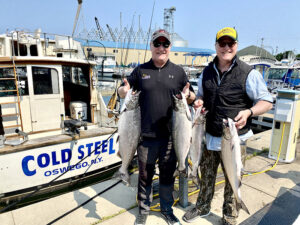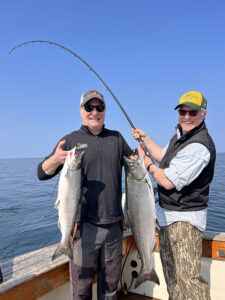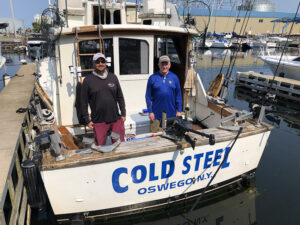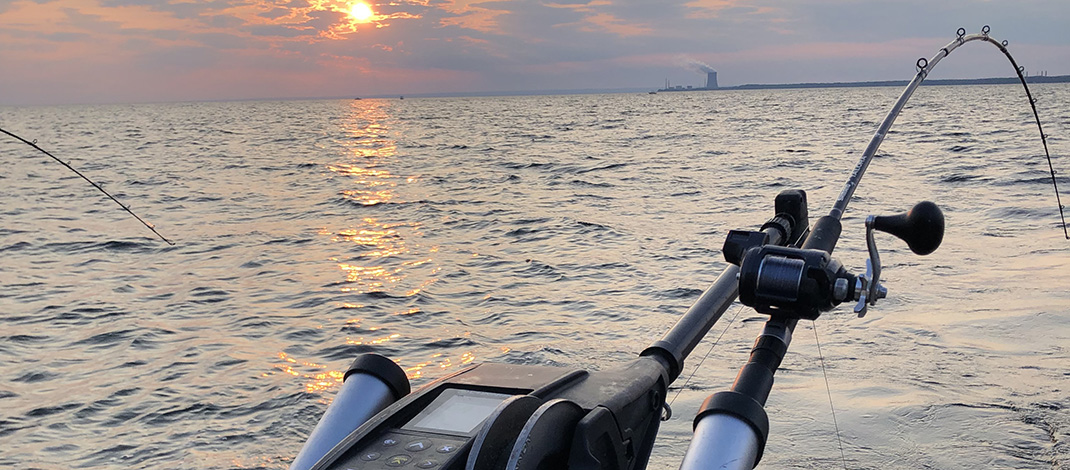A fishing trip on Lake Ontario with Capt. Tom Burke and First Mate Andy Bliss brings good, old memories — and 30 pounds of fresh fish
By Tom and Jerry Caraccioli

Tom Burke and Andy Bliss have been fishing Lake Ontario off the shores of Oswego together for nearly a quarter of a century.
Though they have been together as captain and first mate of one of Lake Ontario’s premier charter fishing boats, Cold Steel Sportfishing Charter, their experience as fishermen on the smallest of the Great Lakes became a calling from an early age for both.
Captain Tom Burke, 58, was born in Brooklyn, where his father and uncle owned a marina. He has been fishing for as long as he can remember. He moved upstate to Moravia in the Finger Lakes region on the southern end of Owasco Lake when he was 4. By the time he and his family moved back down to West Central, New Jersey, when he was 14 years old, fishing in the rural streams, reservoirs and ocean became a big part of his life.
When he finally got his driver’s license and was ready to do more fishing on the Jersey Shore, the stripers fishing dried up. So, he looked north to Lake Ontario as salmon and trout fishing was beginning to boom in the Central New York region. When he was 23 he moved to the Oswego-Pulaski area to work the river and lake fishing seasons. A stretch of life between the ages of 26-32 also saw him get experience in the fishing industry by working summers in the Alaskan salmon fisheries before settling back full-time in the Oswego area in 1989-90. He bought his own lake boat and has been fishing the waters of Lake Ontario ever since.
First Mate Andy Bliss, 43, also a downstater who grew up in Nyack, just north of New York City, caught his first fish — a snapper — in the Hudson River when he was 2. He nurtured his love of fishing in Lake Ontario in 1986 when his grandparents would visit Upstate to camp and fish. They eventually relocated to Sodus Bay several years later. The move gave the young first mate an opportunity to start fishing off the shores of Lake Ontario and Oswego on a regular basis every summer when he would spend time visiting his grandparents.
“In 1994, my freshman year in high school, I was 14 years old and got a job working on a charter boat as a mate,” Bliss explained. “I worked with Dave Hathaway, Double O Charters, and as my high school years went by, I worked summer charters with most of the captains in Sodus Bay.”
Four years later when it came time to choose a college, Bliss thought about Rochester Institute of Technology for a moment before realizing that the backyard of his future dorm at SUNY Oswego was Lake Ontario. That was all that was needed for him to be persuaded to apply for early acceptance.
During his freshman year at Oswego State, Bliss met the captain of his future charter boat career by way of a weird coincidence. The student had been speaking with a local taxidermist and asked him if he knew anybody that needed help. The taxidermist mentioned Burke.
“I gave Tom a call and the first trip we did was May 23, 1999,” Bliss remembered. “I went out [the night before] to watch “Star Wars Phantom Menace” from 6 p.m. to midnight and then got up early to do a charter. Almost 25 years later we’re still working together. So, I guess I did something right.”
“He was fairly young but had some good experience working on the lake,” Burke remembered of his first mate. “He was smart and had a good memory. Basically, whatever he learned he would remember and kept building on that knowledge. It’s worked out pretty well.”
120-150 Trips on Lake Ontario

For Burke and Bliss a typical charter season consists of making about 120-150 trips on the lake from May to mid-September. They are one of about 30-35 charter boats that launch from the Port of Oswego. And they have chartered people from around the world and more than 40 states including many from the northeast and New England, Pennsylvania, New Jersey, Maine and Vermont, as well as European guests from Iceland, England, Germany, Poland and even Russia. Many heard about the great fishing in Oswego because they went to school here or worked in the area at some point.
Though many may think the charter fishing industry is all about cash and business, it’s not. Like many things, it’s about people, interaction and relationship building. The process of finding the right charter and organizing a trip is part feeling, organization, as well as some science. It’s much like when the captain and first mate decide where they’re going to set up the downriggers for the optimum chance of hooking the big fish.
“Once you narrow down a captain that you want to fish with, pick a date that works best for both of you, then the captain will suggest the best time to go,” explained Bliss. “They will be honest and suggest the best time to go when the fish are hitting. After that, find lodging. There are lots of great places to stay in Oswego within walking distance of the marina and they give discounts to people with charters. Also, make sure you have your fishing license and then show up with a positive attitude. It’s not a ‘price for pound’ proposition. This is about having fun, enjoying the great outdoors and spending time with the people that are important to you.”
Our trip to Lake Ontario

Fast forward to June 21, 2023. The first day of summer means different things to different people. In scientific terms, the summer solstice denotes the day in which the earth’s tilt toward the sun is at a maximum and the sun appears at its highest elevation at noon. It is known as the longest day of the year in the northern hemisphere.
Burke and Bliss met us early on Wednesday morning just after dawn and before sunrise to take us to a place we hadn’t been in decades — the waters of Lake Ontario to go fishing.
It had been more than 40 years since our Uncle Dick Coyer used to take us out on the lake fishing. Back then, we weren’t big fishermen; hockey and baseball were our games. But we did always enjoy when our uncle would call to invite us to go out on his boat to go fishing for perch or brown trout, and he would say, “Now, you’re on my hockey rink.” He taught us how to bait a hook, take the fish off it when we reeled them in, and clean them when we got home. The charter boat industry was burgeoning, but not like today.
We boarded the Cold Steel from slip 12 at the Port of Oswego Marina. For the captain and first mate who patrol Lake Ontario and the rivers of Oswego County for business and pleasure, the first day of summer also means a transition from fishing for brown trout, steel head and bass to diving deeper into Lake Ontario for coveted king, chinook and coho salmon.
As we made our way out on Lake Ontario with the sun rising in the east, the part of fishing that many people don’t think about or realize was happening. Catching king salmon doesn’t just happen by chance, though plenty of luck is involved. It truly is a science.
And Burke and Bliss have it down as they scanned their radar systems trying to glean information about the currents and water temperatures in order to find the best spots to lower the downriggers.
“A lot of fishing in small lakes or oceans you have structure,” explained Captain Burke. “The fish will orientate off the structure. Lake Ontario has a few spots with some structure but it’s mainly a wide-open lake. So, we have to narrow it down to get these fish. Due to the points of land that stick out and winds, we do have certain current lines that form. They stay pretty consistent where they are. The current will bring little stuff like plankton that gets caught up in it and gets pulled along. That is what the bait is going to feed on. So, the bait will stay just below the current, just above it or through it once in a while looking to feed. The fish know it and will orientate to the same thing waiting to see the bait come around feeding.”
On this day, we were fishing the edges of one of the current lines about two miles offshore past the breakwall and Oswego’s famous lighthouse at about 60 to 140 feet with six lines set at various depths. We were trolling back and forth through the current trying to find the fish using trolling spoons, attractors, flashers and dodgers that imitate small salmon swimming.
“Sometimes you will find one depth is good and you just stay right in that depth for a while,” Burke explained.
It seemed like we had found the right depth almost immediately at 60-80 feet. We started our voyage at 5:30 a.m. and by 5:48 a.m. we had our first hit, and another about a half-hour later.
Captain Burke further explained the science of the depths we were fishing at that point.
“The higher rods seem like they’ve gotten the action. That will happen earlier in the morning as the salmon will tend to stay up a little higher in the low light area and hang in their preferred 52-55 degree temperatures. As the sun gets brighter and there is more light penetration, the salmon will tend to go deeper and colder in order to again get to the lower light area in order to keep the advantage over the bait. Thus, you will start to catch them 10-20 feet deeper. Basically, the predator salmon has better eyesight than the prey bait, so they try to find the right light amount in order to maintain the advantage.”
Though we didn’t get that first hit or the next one into the boat, they were a precursor to plenty of action and good things to come. The captain was spot on with his analysis when, at around 6:45 a.m. and then 20 minutes later, we landed a 9-pound and 12-pound king salmon. Then, within the course of about 100 minutes from 8-9:40 a.m., we landed nine more king salmon. In total we landed 11 ranging in size from 20-31 inches and in weight from 9 to 20 pounds.
At the end of the morning as we docked, keeping four of the bigger fish, we walked over to Tom Wojslaw and had them filleted for us for $4 a fish. We went home with about 30 pounds of fresh, clean, beautiful salmon that we gave to our brother to have smoked and some was cooked that night by our sister for a delicious dinner.
One of the great things about being out on Lake Ontario on a beautiful day is the fresh air, sunshine and bright colors of the water and sky. Of course, we went to relive the experience of fishing with our uncle when we were kids and to feel the anticipation and rush of excitement watching for a pole to release signifying a fish is on. The fact that we were lucky enough to catch some beautiful fish was the bonus.
“We all love fishing and being in the outdoors,” Bliss said. “But making smiles is the best part. People always ask what I do for a living and I tell them, ‘I put smiles on faces.’ I love the camaraderie of fishing. I love the relationships we build and the lifelong friends we make. Every day I have the chance to meet a new set of friends.”
Burke and Bliss are consummate, professional fishermen. Their love of Lake Ontario and their charter fishing profession is overflowing. Even after 25 years it continues to show. And, the smiles on the faces of their new friends — from the memories they helped make — will show for a lifetime.
Tom and Jerry Caraccioli are freelance writers originally from Oswego, who have co-authored two books: “STRIKING SILVER: The Untold Story of America’s Forgotten Hockey Team” and “BOYCOTT: Stolen Dreams of the 1980 Moscow Olympic Games.”




